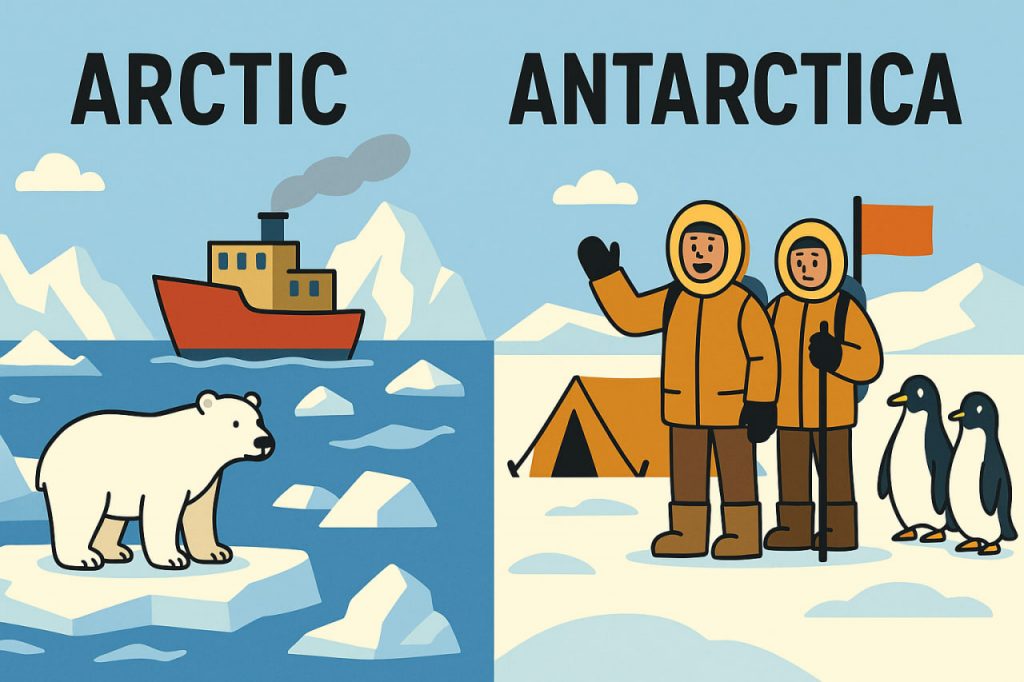The Arctic has fascinated explorers for centuries due to its harsh climate and strategic location. As early as the Viking Age, Norse sailors reached Greenland and parts of North America. Later, in the Age of Discovery, European powers searched for the Northwest Passage — a sea route across the Arctic that would connect Europe to Asia. In the 16th–19th centuries, expeditions from England, Russia, and Norway explored the frozen seas, though many faced tragic fates due to extreme conditions.
Scientific Interest in the Arctic
By the 19th century, exploration became more systematic. Russia advanced along Siberia, while Norwegian explorer Fridtjof Nansen drifted with his ship Fram to study ice movement. In the 20th century, aviation and icebreakers improved access, making the Arctic a subject of scientific, economic, and political interest. Today, with climate change reducing ice coverage, nations are racing to study resources and protect fragile ecosystems.
Early Exploration of Antarctica
Unlike the Arctic, Antarctica remained untouched until much later because of its remoteness. The continent was sighted in the early 19th century by explorers like Fabian Gottlieb von Bellingshausen (Russia) and James Clark Ross (Britain). Expeditions often faced extreme cold, unpredictable weather, and logistical challenges.
The Heroic Age of Antarctic Exploration
From the late 19th to early 20th centuries, Antarctica became the stage for legendary expeditions. Norwegian explorer Roald Amundsen reached the South Pole in 1911, beating British explorer Robert Falcon Scott. Ernest Shackleton’s Endurance expedition (1914–1917) became famous for survival against all odds after the ship was trapped and destroyed by ice.
Modern Scientific Research
In the mid-20th century, Antarctica gained new importance as a scientific frontier. The Antarctic Treaty of 1959 declared the continent a zone for peace and research, banning military use. Today, international research stations study climate, astronomy, biology, and glaciology. Both the Arctic and Antarctica serve as key indicators of climate change and are vital for understanding Earth’s future.
Conclusion
The exploration of the Arctic and Antarctica reflects human determination to understand the most extreme environments on Earth. From dangerous expeditions of the past to international scientific cooperation today, both regions continue to shape our knowledge of the planet.
Interesting Facts
The history of Arctic and Antarctic exploration is a story of human endurance, scientific curiosity, and survival against some of the harshest conditions on Earth. Early Arctic journeys began in the 16th century, driven by the search for a northern sea route between Europe and Asia. Explorers like Fridtjof Nansen and Robert Peary pushed toward the North Pole, facing deadly cold, ice drifts, and months of darkness. In the Antarctic, expeditions started later, with James Cook crossing the Antarctic Circle in 1773 but never sighting the continent itself. The so-called Heroic Age of Antarctic Exploration (1890s–1920s) brought legends such as Roald Amundsen, who reached the South Pole in 1911, and Robert Falcon Scott, whose tragic expedition followed soon after. Interestingly, these polar regions became laboratories for studying climate, glaciology, and astronomy, as their extreme environments mirror conditions found on other planets. Today, both poles remain vital for scientific research and global climate monitoring, continuing the explorers’ legacy of discovery and resilience.
Glossary
- Northwest Passage – a sea route across the Arctic connecting Europe and Asia.
- Icebreaker – a special ship designed to navigate through ice-covered waters.
- South Pole – the southernmost point on Earth, located in Antarctica.
- Glaciology – the study of glaciers and ice.
- Antarctic Treaty – international agreement preserving Antarctica for science and peace.


